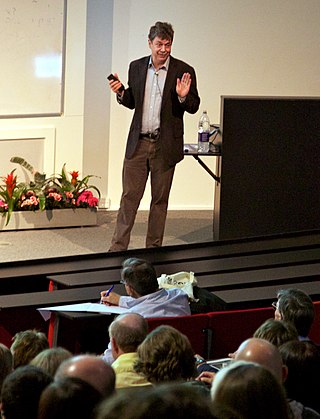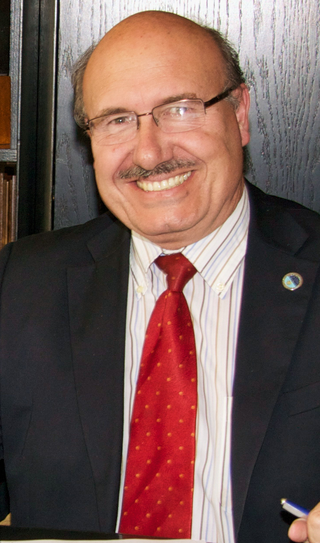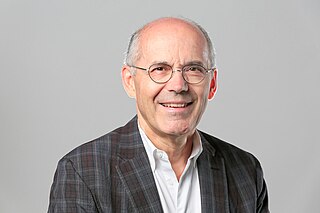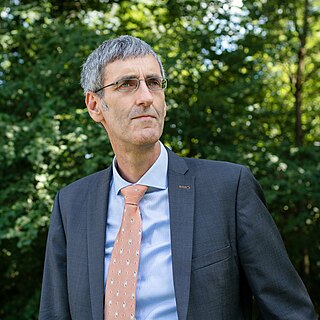Related Research Articles

The Max Planck Institute for Astrophysics (MPA) is a research institute located in Garching, just north of Munich, Bavaria, Germany. It is one of many scientific research institutes belonging to the Max Planck Society.

Reinhard Genzel is a German astrophysicist, co-director of the Max Planck Institute for Extraterrestrial Physics, a professor at LMU and an emeritus professor at the University of California, Berkeley. He was awarded the 2020 Nobel Prize in Physics "for the discovery of a supermassive compact object at the centre of our galaxy", which he shared with Andrea Ghez and Roger Penrose. In a 2021 interview given to Federal University of Pará in Brazil, Genzel recalls his journey as a physicist; the influence of his father, Ludwig Genzel; his experiences working with Charles H. Townes; and more.

Simon David Manton White, FRS, is a British-German astrophysicist. He was one of directors at the Max Planck Institute for Astrophysics before his retirement in late 2019.

Geraint Francis Lewis, FLSW is a Welsh astrophysicist, best known for his work on dark energy, gravitational lensing and galactic cannibalism. Lewis is a Professor of Astrophysics at the Sydney Institute for Astronomy, part of the University of Sydney's School of Physics. He is head of the Gravitational Astrophysics Group. He was previously the Associate Head for Research at the School of Physics, and held an Australian Research Council Future Fellowship between 2011 and 2015.

Priyamvada (Priya) Natarajan is a theoretical astrophysicist and professor in the departments of astronomy and physics at Yale University. She is noted for her work in mapping dark matter and dark energy, particularly in gravitational lensing and in models describing the assembly and accretion histories of supermassive black holes. She authored the book Mapping the Heavens: The Radical Scientific Ideas That Reveal the Cosmos.

The galaxy cluster IRC 0218 hosts the most distant strong gravitational lensing galaxy currently known at a redshift of z = 1.62. The lens is one of the two brightest cluster galaxies and is lensing a background star-forming galaxy at a redshift of z = 2.26 into a bright arc and a faint counterimage. The lens was discovered through a combination of Hubble Space Telescope and Keck telescope imaging and spectroscopy. The discovery and subsequent analysis of the lens was published in the Astrophysical Journal Letters on June 23, 2014 by an international team of astronomers led by Dr. Kim-Vy Tran from Texas A&M University in College Station, Texas and team members Dr. Kenneth Wong and Dr. Sherry Suyu from the Academia Sinica Institute of Astronomy and Astrophysics in Taipei, Taiwan.
Shashikumar Madhusudan Chitre FNA, FASc, FNASc, FRAS was an Indian mathematician and astrophysicist, known for his research in Astronomy and Astrophysics. The Government of India honored him, in 2012, with Padma Bhushan, the third highest civilian award, for his services to the sciences.
Alice Eve Shapley is a professor at the University of California, Los Angeles (UCLA) in the Department of Physics and Astronomy. She was one of the discoverers of the spiral galaxy BX442. Through her time at University of California, Los Angeles (UCLA) she has taught Nature of the Universe, Black Holes and Cosmic Catastrophes, Cosmology: Our Changing Concepts of the Universe, Galaxies, Scientific Writing, AGNs, Galaxies, *and* Writing, and The Formation and Evolution of Galaxies and the IGM. Shapley has committed herself to over a two decades of research and publication in the interest of physics and astronomy.

SN Refsdal is the first detected multiply-lensed supernova, visible within the field of the galaxy cluster MACS J1149+2223. It was named after Norwegian astrophysicist Sjur Refsdal, who, in 1964, first proposed using time-delayed images from a lensed supernova to study the expansion of the universe. The observations were made using the Hubble Space Telescope.

Vassiliki Kalogera is a Greek astrophysicist. She is a professor at Northwestern University and the director of the Center for Interdisciplinary Exploration and Research in Astrophysics (CIERA). She is a leading member of the LIGO Collaboration that observed gravitational waves in 2015.

Rafael Rebolo López is a Spanish astrophysicist. In October 2013 he became the director of the Instituto de Astrofísica de Canarias. He is a professor at the Spanish National Research Council. In 2002 Rebolo became an external professor at the Max Planck Institute for Astronomy and a member of the Max Planck Society.

Georges Meylan is a Swiss astronomer, born on July 31, 1950, in Lausanne, Switzerland. He was the director of the Laboratory of Astrophysics of the Swiss Federal Institute of Technology (EPFL) in Lausanne, Switzerland, and now a professor emeritus of astrophysics and cosmology at EPFL. He is still active in both research and teaching.
Claudia Maraston is a Professor of Astrophysics at the University of Portsmouth. She designs models for the calculation of spectro-photometric evolution of stellar populations. She is the winner of the 2018 Royal Astronomical Society Eddington Medal.
Sera Markoff is an American astrophysicist and full professor of theoretical high energy astrophysics at the Anton Pannekoek Institute for Astronomy, University of Amsterdam. She is a member of the Event Horizon Telescope team that produced the first image of a black hole.

Dara J. Norman is an astronomer and the deputy director of the Community Science and Data Center at the National Science Foundation's National Optical-Infrared Astronomy Research Laboratory (NOIRLab) in Tucson, Arizona. She is also the Association of Universities for Research in Astronomy Diversity Advocate at NOAO. Her research centers on the influence of Active Galactic Nuclei (AGN) on the evolution of galaxies. In 2020, she was inducted into the inaugural cohort of American Astronomical Society Fellows in recognition of her leadership and achievements.

Frank Eisenhauer is a German astronomer and astrophysicist, a director of the Max Planck Institute for Extraterrestrial Physics (MPE), and a professor at Technical University of Munich. He is best known for his contributions to interferometry and spectroscopy and the study of the black hole at the centre of the Milky Way.
Irene Tamborra is an Italian particle astrophysicist, specializing in the areas of neutrino astrophysics and cosmology as well as multi-messenger astronomy. She is professor of particle astrophysics at the Niels Bohr Institute, University of Copenhagen.
Paola Caselli is an Italian astronomer and astrochemist known for her research on molecular clouds, star formation and planet formation, and the astrochemistry behind the materials found within the Solar System. She is the director of the Max Planck Institute for Extraterrestrial Physics near Munich in Germany. She also holds an honorary professorship at Ludwig Maximilian University of Munich.
You-Hua Chu is a Taiwanese astronomer. She has served as the director of the Institute of Astronomy and Astrophysics, Academia Sinica and the chair of the Department of Astronomy at the University of Illinois at Urbana-Champaign. Her main research areas are interactions between the interstellar medium and stars and observations of planetary systems in the post main sequence stages.
Karin Lind is a Swedish astronomer whose research involves spectroscopy of stars in order to determine their chemical composition, and the use of this information to understand the origin of heavy elements in supernova explosions and the way radiation and energy moves through stellar atmospheres. Her work has in particular clarified the roles of Big Bang nucleosynthesis and supernovas in producing the quantities of lithium observed in early stars. She is an associate professor in the Department of Astronomy at Stockholm University, and a participant and survey builder in the GALAH collaboration, which uses the Anglo-Australian Telescope's HERMES instrument to map the chemical compositions of stars in the Milky Way.
References
- ↑ Clark, Stuart (26 January 2017), "Speedy universe expansion challenges Einstein's theory", The Guardian, retrieved 2024-10-01
- 1 2 3 "Prof. Dr. Sherry H. Suyu", Professors, Technical University of Munich, retrieved 2024-10-01
- 1 2 3 Khullar, Gourav (14 January 2021), "Meet the AAS Keynote Speakers: Prof. Sherry Suyu", Astrobites, American Astronomical Society, retrieved 2024-10-01
- 1 2 3 4 Holy Cow! Sherry Suyu to Receive 2021 Berkeley Prize, American Astronomical Society, 30 July 2020, retrieved 2024-10-01
- ↑ "Sherry H Suyu", AstroGen, American Astronomical Society, retrieved 2024-10-01
- ↑ Sherry Suyu selected as Max Planck Fellow, Max Planck Institute for Astrophysics, 19 October 2022, retrieved 2024-10-01